Morelia, Michoacán 作者: 来源: 发布时间:2021-05-27
1.Populaiton and Area
Pop.: 784,776 (munip.)
Area: 1335.94 km2
Elev.: 1,920 masl
Morelia location in Mexico within the State of Michoacán
https://goo.gl/maps/TFAs53ofZMqDgBv57
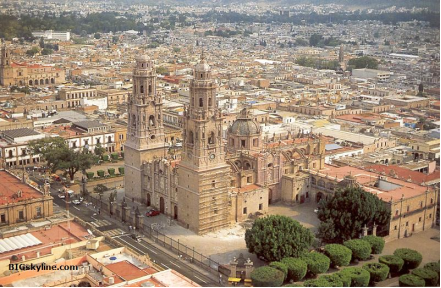
2. Natural geography
The municipality is located in the hydrographic region number 12, known as Lerma-Santiago, particularly in the Irrigation District Morelia-Querétaro. It is part of the Lake Cuitzeo basin. Its main rivers are the Grande and the Chiquito. These two rivers came to surround the city until the middle of the 20th century. The Rio Grande was canalized at the end of the century. XIX due to frequent overflows. The Rio Grande has its origin in the municipality of Pátzcuaro and runs for 26 km through the municipality of Morelia (it crosses the municipal seat), and empties into Lake Cuitzeo (the second largest in the country). The main runoffs that feed this river are the Lagunillas stream, the Tirio streams and the San Pedro ravine. The Chiquito River, 25 km long, is the main tributary of the Grande River and originates in the mountains of La Lobera and La Lechuguilla, and later joins with the streams La Cuadrilla, Agua Escondida, El Salitre, El Peral, Bello, and the Carindapaz.
Regarding the bodies of water in the municipality, there are the Umécuaro and Loma Caliente dams, as well as the Cointzio dams, the most important in the municipality, with a capacity of 79.2 million cubic meters. Another important water supply resource in the municipality of Morelia is the springs, highlighting for its use the Mintzita spring, used for the supply of drinking water for an important part of the population of the city, as well as for industrial uses. Also important are the hot springs that are used as spas, including Cointzio, El Ejido, El Edén and Las Garzas. Returning to the Chiquito river, it was one of the most prominent rivers in the municipality but over the years it has stopped having clean waters, now the river is very dirty and there are no animals as there used to be before the general population polluted it Rivers, lakes and seas are very important for municipalities, cities, states, countries and even for continents, springs are a very good source to obtain drinking water for the population of a municipality, state, etc.
The surface of the municipality is very rugged, since it is located on the Transversal Neovolcanic Axis, which crosses the center of the country, from east to west, however, the growing urban development of the city of Morelia has led to the population of the mountains , hills and hills surrounding the historic center of the city, which in turn has fostered the need to increase the existing infrastructure to integrate new urban settlements.
The physiography of the municipality has the following composition:
·Sierra (S): 53.57% of the municipal surface.
·Sierra with lomeríos (SL): 15.71% of the municipal area.
·Plateau with hills (ML): 11.58% of the municipal surface.
·Lomeríos (L): 3.05% of the municipal surface.
·Valley with hills (VL): 2.46% of the municipal surface.
·Plain with hills (VL): 4.93% of the municipal surface.
·Plain (V): 13.63% of the municipal surface.
Weather
Köppen Classification: Oceanic Subtropical Highland Climate
The subtropical highland variety of the oceanic climate exists in elevated portions of the world that are within either the tropics or subtropics, though it is typically found in mountainous locations in some tropical countries. Despite the latitude, the higher altitudes of these regions mean that the climate tends to share characteristics with oceanic climates, though it also tends to experience noticeably drier weather during the "low-sun" season. In locations outside the tropics, other than the drying trend in the winter, subtropical highland climates tend to be essentially identical to an oceanic climate, with mild summers and noticeably cooler winters, plus, in some instances, some snowfall. In the tropics, a subtropical highland climate tends to feature spring-like weather year-round. Temperatures here remain relatively constant throughout the year and snowfall is seldom seen.Without the elevation, many of these regions would likely feature either tropical or humid subtropical climates.
The Köppen Climate Classification subtype for this climate is "Cwb". (Oceanic Subtropical Highland Climate).
The average temperature for the year in Morelia is 66.2°F (19°C). The warmest month, on average, is May with an average temperature of 71.2°F (21.8°C). The coolest month on average is January, with an average temperature of 60.4°F (15.8°C).
The highest recorded temperature in Morelia is 102.2°F (39°C), which was recorded in March. The lowest recorded temperature in Morelia is 21.2°F (-6°C), which was recorded in December.
The average amount of precipitation for the year in Morelia is 30.7" (779.8 mm). The month with the most precipitation on average is August with 6.8" (172.7 mm) of precipitation. The month with the least precipitation on average is March with an average of 0.2" (5.1 mm). In terms of liquid precipitation, there are an average of 107.0 days of rain, with the most rain occurring in July with 22.2 days of rain, and the least rain occurring in December with 1.3 days of rain.
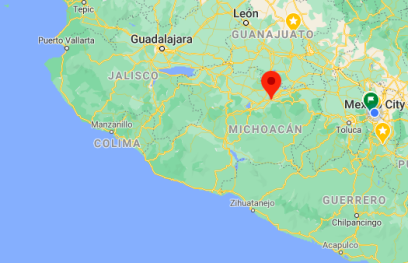
Getting there and around
By Air – You can fly to Morelia from the USA and other points in Mexico including Mexico City, Guadalajara and Leon. Morelia has become extremely well-connected by air from serveral US cities in recent years. Mexicana Airlines flies non-stop between Dallas Forth Worth and Morelia and between Los Angeles and Morelia. Continental Airlines also flies from Los Angeles to Morelia, and from Houston to Morelia. The Houston connection is particularly useful for people connecting from other US cities, Canada and Europe as Houston is Continental’s principal hub. The airport is about 15 miles away from the city center and taxis will be standing by to take you into town when your flight arrives.For detailed information about flights and flying, see the Mexperience guide to Air Travel in Mexico.
By Bus – You can travel to Morelia on a luxury bus from Mexico City – the trip takes around 4 hours. The buses depart from the Western Bus Terminal (Terminal de Autobus Poniente) – and are frequent and plentiful. For detailed information about bus transportation read the Mexperience guide to Bus Travel in Mexico.
By Car – Driving to Morelia from either Guadalajara or Mexico City (Morelia is equidistant from these two cities, the drive takes 3-4 hours) is fairly easy using Highway 15, a high-speed toll road. See additional information about Driving in Mexico and Mexico’s Toll Roads on Mexperience.
Car Rental – To explore Mexico’s colonial towns and cities, consider renting a car for your visit. Having your own car will give you more flexibility than using public transport options and, in some cases, offer you access to places which are otherwise difficult to visit without the use of a car. Read our guide to Car Rental in Mexico to learn what you need to know about car rental in Mexico and connect to the Mexperience Travel Center to reserve your Rental Car.
Taxis – Taxis in most of Mexico’s colonial towns and cities are not metered, so agree your price before you get in. Taxi travel is very affordable in Mexico, in comparison to the USA, Canada and Europe, and so provides a viable means of public transportation in Mexico. Your hotel can arrange taxis for you; some post their rates on a board in the lobby; taxi hotel rates are usually higher than cabs you hail off the street. If you speak Spanish, you will have a distinct advantage and be able to negotiate a price with the driver. For detailed information, read the Mexperience guide to Taxi Travel in Mexico.
https://www.mexperience.com/travel/colonial/morelia
Uber is expanding rapidly across Mexico and now offers services in cities across the country, including: Mexico City, Toluca, Cuernavaca, Puebla, Querétaro, León, Aguascalientes, San Luis Potosí, Guadalajara, Monterrey, Hermosillo, Tijuana, Mexicali, and Mérida. Uber has been adding Mexican cities to its network every year, check for availability when you arrive at your destination in Mexico.
Cabify is developing also and currently operates in cities including Mexico City, Toluca, Monterrey, Puebla, Querétaro and Tijuana. Check for availability in the city you are visiting.
The services offers people with smartphones a way to book a cab through a mobile app for a pre-agreed price. Fares are comparable with Sitio type cabs (see above), and sometimes trade at a premium to this when local demand increases.
https://www.mexperience.com/transport/taxi-travel-in-mexico/#51
3.GDP
GDP: 50,695.2 M MXN
4. Industry
According to the document Indicators of Wholesale and Retail Trade, INEGI Economic Statistics, published in July 1997, the economic activities of the municipality, by sector, within the unspecified activities, a 3.77% is contemplated. In this way, the main economic activities of the city are commerce and tourism (tertiary sector) and then the construction and manufacturing industries. On the other hand, the National Survey of Occupation and Employment (ENOE) of INEGI shows the following absolute values of the employed, underemployed and unemployed population over 14 years of age employed in the quarters of 2005 and 2006. And they are distributed as follows :
·Primary Sector (agriculture, livestock, hunting and fishing): 6.64%.
·Secondary Sector (manufacturing industry, construction, electricity): 25.91%.
·Tertiary Sector (commerce, tourism and services): 63.67%.
Morelia, despite its significant demographic growth, has had a slow industrial development compared to that of many other cities in the center and north of the country, mainly due to the lack of adequate infrastructure, as well as the little promotion of investments industrial-type throughout the state. In the capital of Michoacán is the Industrial City of Morelia (CIMO), which covers 354 hectares and accommodates 180 companies that generate 9 thousand 50 jobs (February 1, 2007). However, only 30% of them are manufacturing companies, while the rest are warehouses or distribution centers and there are no large companies, only medium and small ones. Among other activities, the Morelia industry is dedicated to the production of edible oil, chemical products, resins, flour, foundry, plastic, boilers, canned sweets, bottling of water and soft drinks, of plastics, manufacture of electrical equipment. In 2014, the Dish company installed its customer service center in the Tres Marías technology park. Starting in 2017, the Liverpool Department Store Customer Service Center will begin operations, also installed in the Tres Marías technology park.
5. Touristic sites
Colonial Downtown
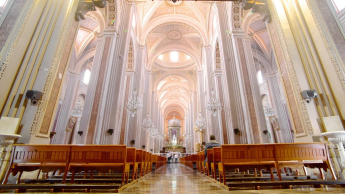
An impressive pink stone cathedral dominates the main plaza, which is surrounded by beautiful colonial buildings. The cathedral is said to have taken over 100 years to build and is one of the finest (if not the finest) in all of Mexico.
The cathedral’s twin towers, large organ and sculpture of the Crucifixion (Senor de la Sacristia) are worth a visit.
One of Morelia’s most prominent architectural features is the El Acueducto (the aqueduct), which is an artificial channel that brings water from one location to another. Morelia’s aqueduct runs along dozens of colonial arches that stretch for over a mile across the city. You’ll probably travel under at least one of the arches while you’re in town, so you can’t miss it.
Casa Museo de Morelos
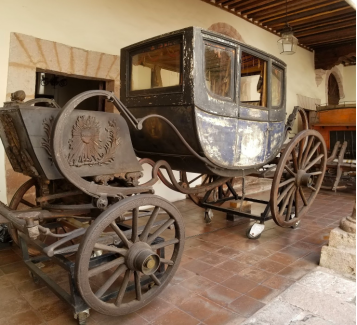
The property is one of the most important historical monuments of the city and the country, since it belonged to one of the most illustrious heroes in the history of Mexico, such as Don José María Morelos y Pavón. The house was declared a National Monument in 1934 by the Directorate of Colonial and Republic Monuments.
The Casa de Morelos Museum pays tribute to one of the most important military strategists in our history, a statesman and politician, the greatest visionary as an architect of the institutions, which among his greatest contributions are the "Sentiments of the Nation" and the Constitution of Apatzingán. Without a doubt, Morelos was one of the great architects of the country we know today.
The Museum has nine rooms in which it shows a collection of 300 historical pieces, innovative museum resources and a new script based on the latest advances in historiographic research, derived from a comprehensive restructuring of which it was subjected and which ended with its reopening in December from 2009. This museum complex is housed in a typical Valladolid house from the 18th century, characterized by its sobriety, typical of a non-prominent family; It is located in what was a humble neighborhood on the outskirts of Valladolid during the Colony.
https://www.inah.gob.mx/red-de-museos/296-museo-y-archivo-historico-casa-de-morelos
Morelia Cathedral
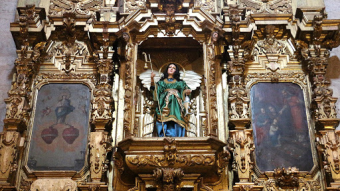
This Baroque-style complex began its construction in 1680 and was completed in 1737. It belonged to the Capuchin Poor Clare sisters and was used to house the Indian maidens, daughters of chiefs and the Capuchin nuns.
A fire consumed the main altar and only 3 baroque altarpieces remain. And over time it has undergone numerous renovations. In 1908 the part that worked as a convent was demolished.
The most relevant thing about the temple is its colorful interior that contrasts with its sober exterior. Inside the religious construction you can find gold-colored boards with themes such as the passion of Christ and the Holy Family. Currently only three of the six original boards are preserved.
Adjoining is a beautiful square and a garden that serve as a place of recreation.
https://programadestinosmexico.com/que-ver/arquitectura-colonial/iglesia-de-capuchinas-morelia.html
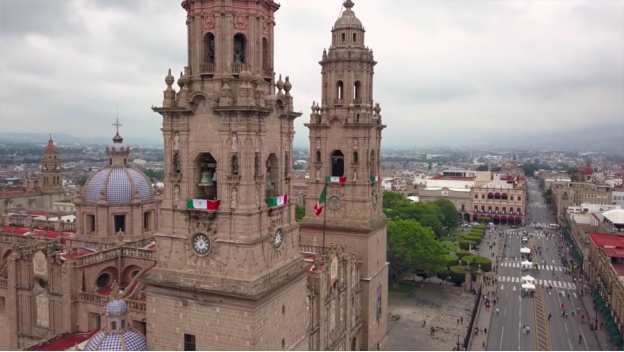
Best Tourist Attractions you MUST SEE in Toluca, Mexico | 2019
https://youtu.be/BNElacIPvNo
6. History and Culture
Human settlements in the Guayangareo Valley in which Morelia is located have been dated back as far as the 7th century. Artifacts found here have shown Teotihuacán culture influence on early cultures in this area. In the 12th century, the Purépecha arrived in the valley. They dominated it politically for the rest of the pre-Hispanic period but did not build any major settlements here. Between the 12th and the 15th century, Matlatzincas moved into the area with permission of the Purépechas, who were based around nearby Pátzcuaro Lake. The main Matlatzinca settlement was where Júarez Plaza in the city is today.
The Spanish pushed into the Guayangareo Valley between 1525 and 1526, headed by Gonzalo Gómez. In the 1530s, the area was evangelized by Franciscans such as Juan de San Miguel and Antonio de Lisboa.
What would become the city of Morelia was founded by Viceroy Antonio de Mendoza and a number of encomenderos in 1541, who first named it Nueva Ciudad de Mechuacan (New City of Michoacán). The newly founded settlement grew quickly, prompting Vasco de Quiroga to go to Spain and procure for rival settlement Pátzcuaro the title of city and a seal, to prevent “new city” from becoming the capital of Michoacán. The action also required that the new settlement change its name to Guayangareo. In 1545, Guayangareo gained city status from Charles V in 1545 with the name of Valladolid, after the hometown of Antonio de Mendoza. This was part of a power struggle between Antonio de Mendoza and Vasco de Quiroga over the province of Michoacán. During Quiroga's lifetime, he managed to keep political and ecclesiastical power in Pátzcuaro despite the viceroy's and encomenderos’ objections. However, Quiroga died in 1565. By 1580, both political and religious authority (Episcopal see) had been transferred to the city of Valladolid, moving the College of San Nicolás, which Vasco founded and laying the groundwork for establishing a new cathedral for the province.
The 17th century saw growth for Valladolid, with the construction of the cathedral and aqueduct. The cathedral was begun in 1640 (finished in 1744) and the aqueduct in 1657 Both of these structures would later be worked on in the 18th century by Master Architect of Valladolid, Diego Durán. During the 17th century, many of the city's large churches and monasteries were established, such as the monasteries of San Francisco, San Agustin, El Carmen and La Merced as well as the convents of Las Rosas, Las Monjas and Capuchinas. Churches include La Compañía, San Juan and La Cruz, but the most important structure built during this time period was the cathedral. The location of this cathedral defined the composition and development of the city from then on.
At the end of the colonial period, Valladolid was a small city with about 20,000 inhabitants. It was also an educational center with four important schools such as the College of San Nicolás. These schools would turn out scholars such as Miguel Hidalgo y Costilla and José María Morelos y Pavón, who were sympathetic to the new republican ideas coming out of post-revolution France and United States. Demonstrations against Spanish rule had been occurring in the town in 1809, culminating in the Conspiracy of 1809. This plot was discovered, with the main conspirators were arrested and sent to other parts of New Spain, which helped to spread republican ideas.
One year later, after forming his army in Guanajuato state, Miguel Hidalgo y Costilla arrived and took over the city, proclaiming the end of slavery in Mexico. The city was taken back by royalist forces soon after. Morelos came here to try and dislodge the royalists but was defeated by Agustín de Iturbide. Another prominent figure in the war, Mariano Matamoros was shot by firing squad on the city's main square in 1814. The city remained in royalist hands until 1821, Iturbide, who had switched sides, and Vicente Guerrero entered the city with the Trigarante Army.
In 1828, the newly created state of Michoacán changed the name of the city from Valladolid to Morelia, in honor of José María Morelos y Pavón. This is the official name it retains today, although its Purépecha name remains Uaianarhio and has had nicknames such as City of Pink (Cantera) Stone, the City of Open Doors, The Rose of the Winds, The Garden of New Spain and religiously as Morelia of the Sacred Heart of Jesus. The city became a municipality in 1831.
The later 19th century is marked by struggles between liberal and conservatives forces in Mexico. During the Revolution of Ayutla, the city was taken by rebel forces under Epitacio Huerta and General García Pueblita, but was taken back in 1855 by forces under Antonio López de Santa Anna. Rebels attacked Santa Anna's troops again a year later. French troops imposing imperial rule entered the city in 1863, with the republican forces moving capital of Michoacán to Uruapan while conservative families in Morelia pledged support for emperor Maximilian I, who then visited the city. In 1867, the city is taken by republican general Nicolás de Régules and the capital of Michoacán returned to Morelia. In 1869, during a rebellion against Benito Juárez’s government, General Epitacio Huerta attacked government positions in the city but were beaten back by forces under Mariano Escobedo.
Filling water jars at a fountain in Morelia, 1906
The first factories were opened in the city between 1868 and 1870, along with the first telegraph line. The railroad followed in 1883, as well as street cars.
In 1910, celebrations are held for the centennial of Independence but tensions are high in the city due to the shortage of grain and the continuation of President Porfirio Diaz in power. One year later, revolutionaries loyal to Francisco I. Madero are welcomed into the city. In 1914, the capital was moved from Morelia to the city of Tacámbaro. The city was then taken by forces under General Sánchez in the same year, and by forces loyal to Francisco Villa in 1915.
In 1920, the Palace of the State Government was briefly taken over by farm workers and others from all over the state. Isaac Arriaga is assassinated here in 1921. The city is attacked again by rebels calling themselves “Delahuertistas” in 1924. The fight mostly occurs in the main plaza with the city defended by General Lopez, Garcia and Avila Camacho.
During the 1960s the street vendors were removed from the historic center of the city, and palm trees that lined the Avenida Madero, the main east-west road, were cut down. In 1966, there was a student revolt at the state university which was put down by the army.
The 1970s and 1980s are marked by construction including the Periferico bypass ring around the city. During the 1980s, damage due to geographic faults, exacerbated by falling water tables from groundwater pumping is noticed. This problem is similar to problems faced by other cities on the Trans-Mexican Volcanic Belt such as Querétaro and Mexico City.
In 1991, the city was declared a UNESCO World Heritage Site due to its well-preserved colonial architecture. In 2001, street vendors were moved again from the historic center to make the area more tourist-friendly. Traffic was rerouted from here as well with the construction of new bypasses. In 2006 and 2007, many of the plazas and gardens in the historic center were remodeled.
In 2008, eight people were killed in a grenade attack.
In 2009, the Morelia metropolitan area was tentatively established as consisting of the municipalities of Zinapécuaro, Álvaro Obregón, Charo, Tarímbaro and Morelia. This initial determination was made by the Secretary of Urbanism and Environment, with further refinements to be made as the municipal presidents of these entities meets to discuss limits, strategies and further actions. One of these actions has been to establish a formal commission to administer the area.
7. Contact Information
City Mayor: Raúl Morón Orozco
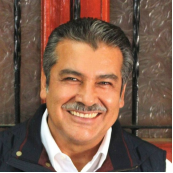
Contact number: +52 (443) 312 3641
Govt. Office Address: Calle Sánchez de Tagle No. 196, Col. Centro, C.P. 58000, Morelia, Michoacán
Twitter: https://twitter.com/raulmoronO
FB: https://www.facebook.com/raulmoronorozco
Website: http://www.morelia.gob.mx
E-mail: gobiernodemorelia@morelia.gob.mx
